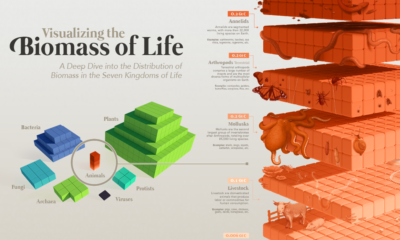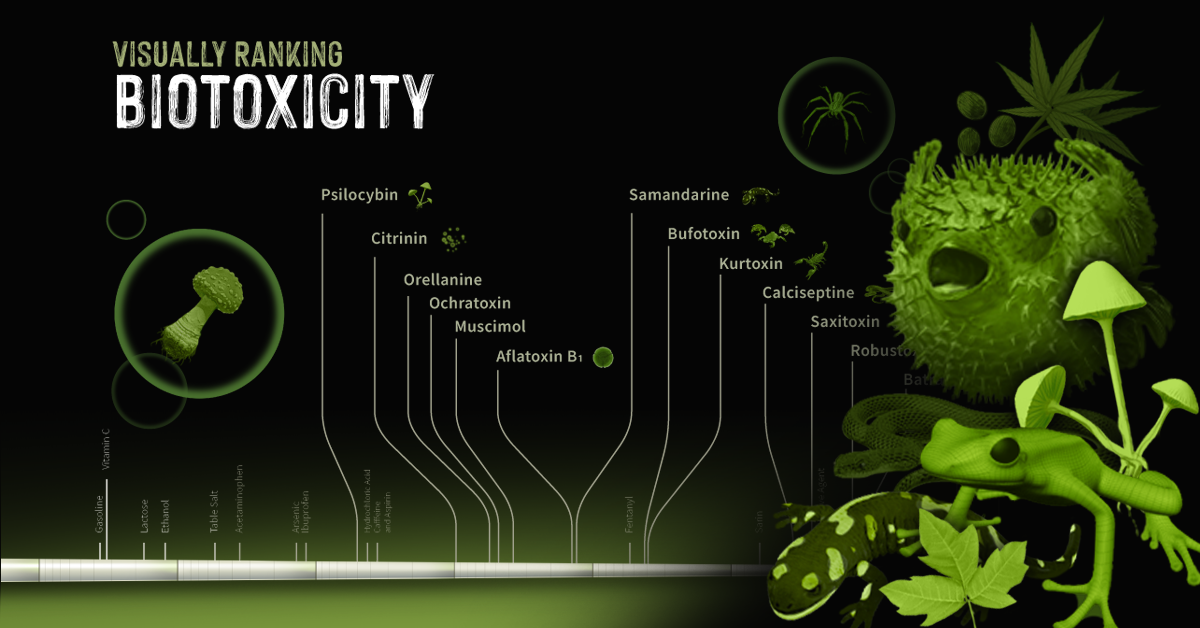Some might argue this is one of mankind’s greatest achievements. With this rise in life expectancy, how do human lifespans now rank compared to other animals? This graphic from Alan’s Factory Outlet covers the life expectancy of 50 different animals ranging from amphibians to arthropods, and even includes one species that’s immortal (well, in theory). Let’s take a closer look at lifespans in the animal kingdom.
The Longest Living Things
Here are some of the longest living animals, where even with advancements in modern medicine, humans are likely far off from matching.
The Deep-Sea Tube Worm
The deep-sea tube worm, also known as Riftia pachyptila, lives until about 250 years old, though in some cases this can stretch much further. Amazingly, they have no digestive system, mouth, or anus, and thus do not consume food to survive in a traditional sense. Instead, the bacteria living inside their bodies helps to transform the sulfur from nearby hydrothermal vents into energy. This makes the deep-sea tube worm one of the few animals on Earth that does not derive its nutrients (either directly or indirectly) from sunlight.
The Immortal Jellyfish
The immortal jellyfish, otherwise known as Turritopsis dohrnii, is biologically immortal. How is this possible? Essentially, these creatures revert and transition backwards from sexual maturity towards sexual immaturity in a process called transdifferentiation—where adult cells are converted into other types of tissue. Not surprisingly, processes like these are getting plenty of human attention in gene therapy and scientific research.
Giant Barrel Sponge
The giant barrel sponge can live for 2,300 years. These cool creatures live on the reef surface of the ocean, and are bowl shaped, which provides habitat for many other invertebrates including crabs, shrimps, as well as fish. In addition, sponges have no tissue and each of their individual cells can do the same job of any other cell. Some experiments have even shown sponges reform and have their cells swim back together when blended up in a blender. If they didn’t, that would be a very cruel experiment.
Human Lifespans: A Rising Trend To Watch
The number of centenarians—those 100 or more years old—stands at 570,000 today. Here are the countries where they are most common compared to their respective populations. While figures in the one-hundredth of a percent range may sound underwhelming, this is still a 1,500% jump from the 33,000 centenarians that lived in the 1950s. Slowly but surely, as human life expectancy continues to grow, our species seems destined to climb up the age ladder—and who knows, we may even be able to eventually live beyond some of the other creatures on this list. on They can take many forms, from the venom of a snake or spider to the neurotoxins produced by certain types of algae or microbes. In the infographic above, we look at some common biotoxins in the natural world and rank them based on how deadly they are to an average 70 kg (154 lb) human being.
Ranking Biotoxins on a Toxic Scale
A basic concept in toxicology is that “only the dose makes the poison”. Everyday harmless substances like water have the potential to be lethal when consumed in large enough concentrations. Measuring a lethal dosage is very difficult. First, living things are complex: factors like size, diet, biochemistry, and genetics vary across species. This makes it difficult to qualify toxicity in a universal way. Second, individual factors like age or sex can also affect how deadly a substance is. This is why children have different doses for medications than adults. Third, how a poison is taken into the body (orally, intravenously, dermally, etc.) can also impact its deadliness. As a result, there are many ways to measure and rank toxicity, depending on what substance or organism is under investigation. Median lethal dose (LD50) is one common way for measuring toxicity. LD50 is the dose of a substance that kills 50% of a test population of animals. It is commonly reported as mass of substance per unit of body weight (mg/kg or g/kg). In the graphic above, we curate LD50 data of some select biotoxins found in nature and present them on a scale of logarithmic LD50 values. What’s surprising is just how potent some toxins can be.
Bits and Bites about Biotoxins
While one would think that biotoxins are avoided at all costs by humans, the reality is more complicated. Here are some interesting facts about biotoxins present in nature, and our unusual relationships with the organisms that create them:
- Fungi and molds make poisons called mycotoxins Mycotoxins are a global problem. They affect crops from many countries, and can cause significant economic losses for farmers and food producers.
- Phytotoxins can defend plants…and attack cancer Plants use phytotoxins to defend themselves other organisms, like humans. Urushiol, for example, is the main toxic component in the leaves of poison ivy, poison oak, and sumac. But the Pacific yew tree produces taxol that’s valuable in chemotherapy treatments.
- Fire salamander toxin is an ingredient in Slovenian whisky Though not widely available, some whisky makers in Slovenia use samandarine from the fire salamander to create a psychedelic alcohol.
- Ciguatoxins exist in the guts of reef fish Very unique species of bacteria living in the digestive tract of reef fishes make ciguatoxin. They transmit this poison to other organisms when the host fish is eaten.
- Pufferfish are deadly, but also delicious Pufferfish contain tetrodotoxin, a potent neurotoxin in their ovaries, liver, and skin called tetrodotoxin. Despite being a delicacy in many countries around the world, it has a lot of strict regulations because of its ability to kill people. In Japan, for example, only specially licensed chefs can prepare pufferfish for consumption.
- Batrachotoxin is lethal to the touch The skin of some poison dart frogs secretes a deadly substance called batrachotoxin. It is so potent that simply touching the poison can be fatal. Indigenous people of Central and South America used batrachotoxin to poison the tips of hunting weapons for centuries.
- Botox contains the most deadly biotoxin known Commercial botox uses an extremely small amount of biotoxin from a microbe called Clostridium botulinum. It paralyzes the muscles, preventing contraction (i.e. wrinkling). It is the deadliest known biotoxin on Earth. One gram of botulinum toxin can kill up to one million people.
Caveats of Measuring and Reporting Biotoxicity
While we use LD50 data to rank biotoxicity, it isn’t an exact science. There is room for improvement. For starters, no LD50 data exists for humans. That means data from other organisms has to be converted to apply to humans. There is a lot of contention amongst scientific communities about how accurate this is. There has also been an increasing effort to move to new methods of measuring toxicity that are not harmful to animals. Several countries, including the UK, have taken steps to ban the oral LD50, and the Organisation for Economic Co-operation and Development (OECD) abolished the requirement for the oral test in 2001. Now, new ways of evaluating toxicity are under investigation, like cell-based screening methods. Correction: Water was mislabeled on a previous version of the infographic. Full sources here












